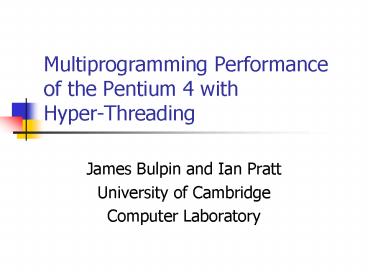Multiprogramming Performance of the Pentium 4 with HyperThreading - PowerPoint PPT Presentation
1 / 15
Title:
Multiprogramming Performance of the Pentium 4 with HyperThreading
Description:
SPEC CPU2000 Benchmarks (INT and FP) Measure standalone run times ... Individual benchmark in a pair up to 40% faster than sequential execution ... – PowerPoint PPT presentation
Number of Views:93
Avg rating:3.0/5.0
Title: Multiprogramming Performance of the Pentium 4 with HyperThreading
1
Multiprogramming Performance of the Pentium 4
with Hyper-Threading
- James Bulpin and Ian Pratt
- University of Cambridge
- Computer Laboratory
2
Introduction
- Simultaneous Multithreading (SMT)
- Fine-grain hardware multithreading
- Processor resources dynamically shared
- Extracts thread-level parallelism
- Intel Hyper-Threading (HT)
- 2 heavyweight threads
- Some static partitioning, dynamic core with some
fairness mechanisms - Shared caches, free-for-all
3
Motivation to Measure
- HT abstracted as independent processors
- Processes can have mutual detrimental effect
- Can improve performance by scheduling processes
that perform well together - More important in multi-package/core systems
- Need to know circumstances where performance lost
4
Duplicating and Deconstructing
- Initial Observations of the Simultaneous
Multithreading Pentium 4 Processor. N. Tuck and
D. M. Tullsen PACT03 - Various multithreaded and multiprogrammed
workloads - We have slightly different hardware and compiler
- We go further on multiprogrammed
- Bias between processes performance
- More analysis of performance counter data
- Compare Hyper-Threading to SMP
5
Experimental Method
- Aim to measure mutual performance effect of a set
of compute-intensive workloads - Dual package 2.4GHz HT Xeon. Linux 2.4.19
- SPEC CPU2000 Benchmarks (INT and FP)
- Measure standalone run times
- Measure runs times for crossproduct of
simultaneously executing pairs
6
Hyper-Threading Results (1)
- Performance for an individual benchmark
- Standalone runtime / runtime in HT pair
- System speedup
- Sum of both performance figures. 1.0 is
equivalent to serial execution - System speedups
- Lowest 0.86 swim vs. mgrid
- Highest 1.50 mcf vs. mesa
- Mean 1.20
7
1.6
1.5
1.4
1.3
Multiprogrammed speedup
1.2
1.1
1
0.9
art
vpr
gcc
eon
mcf
gap
gzip
apsi
twolf
bzip2
swim
applu
mesa
crafty
mgrid
ammp
parser
vortex
equake
sixtrack
perlbmk
wupwise
8
Hyper-Threading Results (2)
9
Hyper-Threading vs. SMP
- Mean speedups HT 20, SMP 77
- SMP 48 improvement on HT
- (HT is worth 65 of SMP)
10
Conclusions
- Individual benchmark in a pair up to 40 faster
than sequential execution - High variance, lots of different behaviour
- Biased performance gains/losses
- Cache contention plays big part
- High L2 miss rates hurt the other threads
- High L1 miss rates benefit from Hyper-Threading
11
(No Transcript)
12
Hyper-Threading Results (1)
13
Best HT System Throughput
14
Worst HT System Throughput
15
SMP Result Matrix































